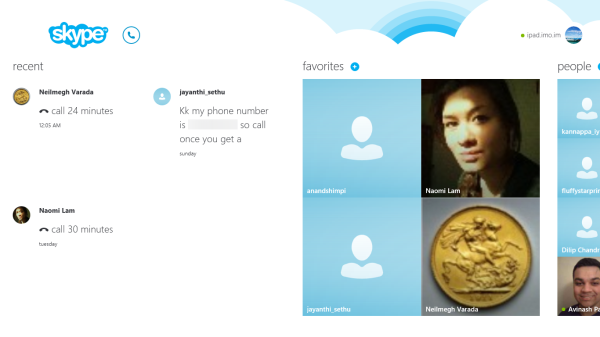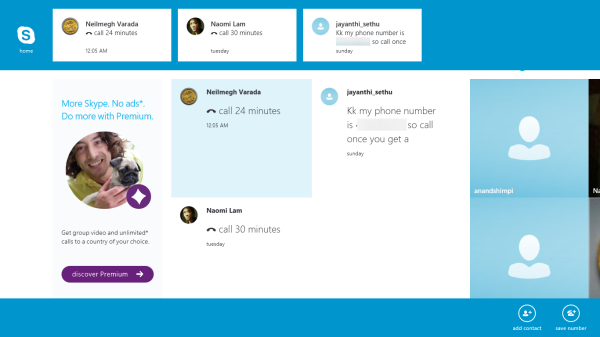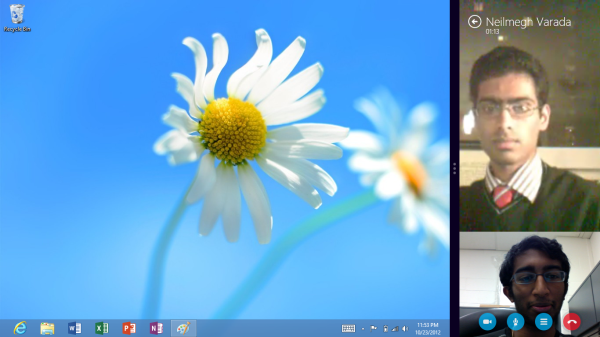The Windows RT Review
by Vivek Gowri & Anand Lal Shimpi on October 25, 2012 12:00 PM EST- Posted in
- Windows RT
- Operating Systems
- Microsoft
- Mobile
- Windows 8
- Tablets
Skype for Windows RT: The New Messenger?
I decided to give Skype its own page, because it’s kind of a hybrid first-party/third-party app and I think it’s going to be very important to Microsoft going forward. It’s not pre-installed so you need to install it from the Windows Store, but Microsoft’s ownership of Skype means that the service is very well integrated to the Windows 8/RT platform.
The new version of Skype runs within Modern UI and has been redesigned from the ground up, with some critical changes being made to the Skype platform. You can login now with any form of Microsoft account, including Skype, and your Skype ID will be linked to your Windows ID. Your Skype contacts can be found either from within Skype or from the People application, so you can just call people directly out of the People application where the rest of your contacts are.
Skype’s new UI is clean and relatable, for the first time in quite a few revisions. Metro has more than done its job here, taking what has become a clunky and archaic interface over the years and really turning it into a modern, streamlined application. There are four areas, showing recent calls and conversations, favorited contacts, and a list of all your contacts as distinct panes. The fourth area, actually the first one you see, is an advertising column for Skype Premium with the sell being “More Skype. No ads.” How tempting. If you’re a free Skype user, like almost everyone I know, it’s just something you ignore but it really does bug me, because it mars what is an otherwise great looking app.
The edge swipe context bar brings up options to add contacts and numbers at the bottom, as well as thumbnails of recent contact history at the top. Once you enter into a contact, you’re free to chat with them, call them over voice or video, or add participants for a group chat. Overall, it’s well organized and very straightforward to use.
The cool part is that you can snap video chats to the edge of the screen, giving you a slice of the chat window. This is actually a really awesome way of doing things, since as long as the other person is generally in the middle of their webcam field of view, the 320 pixel width is actually more than adequate to carry on a good Skype conversation. I’m a big fan of using snapped applications for multitasking, and I think Skype’s implementation of it is very sleek. For the first time in a while, I’m very pleased by the design and responsiveness of Skype.
Eventually I think MSN/Live Messenger will be folded into Skype, paving the way for Skype to become the default messaging client for the Windows platform. The first step in this was combining the Skype ID with the overall Windows ID, and in time we will see how important this was for Microsoft to get right.













233 Comments
View All Comments
The0ne - Friday, October 26, 2012 - link
The same search may not present you with the same results however due to changes in Windows 8 but essentially it should be the same.For those complaining this is what you need to make Windows 8 more like Windows 7, completely! Try, love it and move on.
http://classicshell.sourceforge.net/
mga318 - Thursday, October 25, 2012 - link
Really? Are you serious?You have no idea about the specialized software needs of other fields of study...
VivekGowri - Thursday, October 25, 2012 - link
Sorry, sweeping generalization, but I can't think of a class I took in the first two or three years of undergrad that an RT system wouldn't have been adequate for. Only after you start getting into the upper division classes do you start having a lot of non-Office computing needs.SetiroN - Thursday, October 25, 2012 - link
the general public using facebook only are going to keep buying iPads, not windows tablets with physical keyboards.ARM's power consumption advantage is very marginal: the medfield based RAZR i has shown better standby than the almost identical RAZR M, as well as amazing talktime and slightly better video reproduction power consumption; where it fares worse is normal screen-on usage, but overall, it's hardly worse.
So although there still aren't tests available of the newer dual core, I see no reason to expect worse standby power consumption (considering how intel manages to turn cores off completely); also cloverfield supports connected standby, which both ARM and RT do not, and it seems to be a pretty big deal to me.
Clovertrail will run standard windows 8 (call it home premium if you will) which is as full as it gets unless you consider the pro features essential: it will still be able to run windows 8 pro anyway so it's up to OEMs to offer that version preloaded.
As far as I know, the only difference between clovertrail tablets and standard PCs is that the software will be preloaded and the bootloader locked (there is no SATA support anyway); so with the exclusion of other OSs, you will be able to run all the x86 software you want.
So, to the original question: why in the world would I prefer an ARM solution?
SetiroN - Thursday, October 25, 2012 - link
And I don't believe we have to thank RT for Clovertrail: it was clear that Intel would have entered the mobile market, in competition with ARM, anyway.SetiroN - Thursday, October 25, 2012 - link
By "in competition with ARM" I mean It couldn't have done it at higher prices.VivekGowri - Thursday, October 25, 2012 - link
The only thing with Clovertrail is that it comes out to around $200-250 more if you want Office and a keyboard attachment. See $599 VivoTab RT/Surface RT versus the Samsung Series 5 Slate (or whatever they're calling it in the US - ATIV something or other.)It's an 11.6" Clovertrail tablet that goes for $749 with the dock. Looks great, too. But the thing is, you toss in Office 13 on top of that (because it's Windows 8, that's not included) and then the price ends up going from iPad range (RT) to ultrabook range (Clovertrail.)
wsw1982 - Thursday, October 25, 2012 - link
The clovertrail basically has the same price as the windows RT. the Acer W510 and Asus Vivo smart all cost 499. The surface RT is also 499 without the keyboard. But what i really don't understand is why those low end netbook level tablet are all much more expensive then the netbook, it make no sense to me. The article said the clovertrail and tegra 3 are actually half of the price of conventional ATOM which are used in all those cheaper netbooks. The netbook has more expensive processors (40 to 20), mother board (less integration), harddisk (320G harddisk is more expensive than the 32G SSD) and some other staffs (keyboard, big battery, touch pad). The only thing more expensive on the tablet is the display, but I don't think the display could cost 200 more then the display on the netbook.hokiesfan - Thursday, October 25, 2012 - link
I've wondered about that as well. For a very marginal bit of extra weight and thickness and a bit less battery life, you can get a CT based tablet. That should have an enormous advantage in horsepower. I just wish there were some reviews of the CT devices. Hopefully soon. The only advantage I see with RT is the included Office.ssiu - Thursday, October 25, 2012 - link
Ditto here about eagerly waiting for Clover Trail Windows 8 tablet reviews. At least anandtech drops some concrete "Clover Trail is faster than Tegra 3 tablets" benchmark results -- hopefully a full review is imminent.